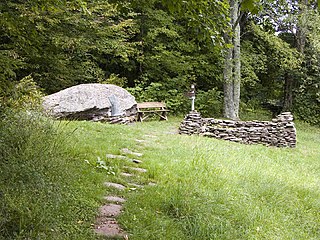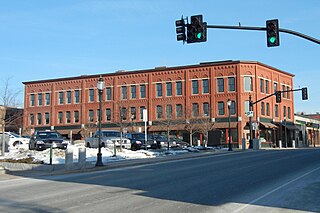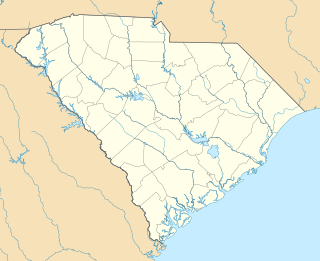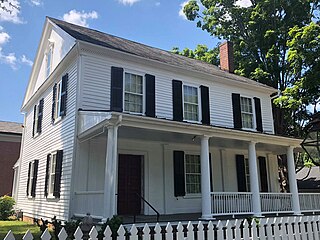
Stagville Plantation is located in Durham County, North Carolina. With buildings constructed from the late 18th century to the mid-19th century, Stagville was part of one of the largest plantation complexes in the American South. The entire complex was owned by the Bennehan, Mantack and Cameron families; it comprised roughly 30,000 acres (120 km2) and was home to almost 900 enslaved African Americans in 1860.

Whitehall is a historic home located at Aiken, South Carolina. It was constructed about 1928 for Robert R. McCormick, one of the owners of the Chicago Tribune. The house was designed by Willis Irvin of Augusta, who won a Gold Medal for Domestic Work at the 1929 Southern Architectural Exhibition with its design. The one-story, brick, U-shaped house was built on the foundation of an earlier, two-story house that had been destroyed by a fire. It is believed that some of the ornate interior woodwork came from the home of John C. Calhoun’s daughter. Whitehall gets its name form the old Whitehall estate on the ruins of which this house was constructed. Whitehall is a Georgian Revival residence. Each of the three sections has a gabled roof. The two projecting wings are pedimented and have a boxed cornice with block modillions, round vents and Doric pilasters at the corners. The central section features a pedimented Doric portico sheltering a central entrance with a semicircular fanlight and sidelights. A Doric entablature extends across the central section. Fenestration is regular six over six with dentiled architraves. It was listed on the National Register of Historic Places on November 27, 1984.

The Graves Light is a lighthouse located on The Graves, the outermost island of the Boston Harbor Islands National Recreation Area, and 9 miles (14 km) offshore of downtown Boston, Massachusetts, USA.

Woodchuck Lodge is a historic house on Burroughs Memorial Road in a remote part of the western Catskills in Roxbury, New York. Built in the mid-19th century, it was the last home of naturalist and writer John Burroughs (1837-1921) from 1908, and is the place of his burial. The property is now managed by the state of New York as the John Burroughs Memorial State Historic Site, and the house is open for tours on weekends between May and October. The property is a National Historic Landmark, designated in 1962 for its association with Burroughs, one of the most important nature writers of the late 19th and early 20th centuries.

The Rev. M.L. Latta House was a historic home located in the Oberlin neighborhood of Raleigh, North Carolina. It was the last remaining building from Latta University, a trade school for African Americans that operated from 1892 until 1920. The house was named after Morgan London Latta, a freedman and former slave who graduated from Shaw University after the Civil War. It was built about 1905, and was a substantial, two-story Queen Anne style residence with a Tuscan order wraparound porch. He founded Latta University to educate freedmen and orphans in Raleigh's African-American community and built the campus next to his house. His house was listed on the National Register of Historic Places in 2002, and designated a Raleigh Historic Landmark.

Wilson Bruce Evans House is a historic house at 33 East Vine Street in Oberlin, Ohio. Completed in 1856, it served a major stop on the Underground Railroad, with its builders, Wilson Bruce Evans and Henry Evans, participating the 1858 Oberlin-Wellington Rescue, a celebrated rescue of a slave. It was declared a National Historic Landmark in 1997.

The Masonic Block is an historic commercial block in Reading, Massachusetts. This three story brick building is distinctive in the town for its Renaissance Revival styling. It was built in 1894 by the local Reading Masonic Temple Corporation, and housed the local Masonic lodge on the third floor. The building was listed on the National Register of Historic Places in 1984.

Alston-DeGraffenried Plantation or Alston-DeGraffenried House is a historic property located in Chatham County, North Carolina, near Pittsboro, North Carolina. It includes a plantation house built through the forced labor of at least 11 enslaved people between about 1810 and 1825, and its surrounding agricultural fields. The property was first listed on the National Register of Historic Places in 1974 and the listed area was increased in 1993. The house and the surrounding land are identified as a national historic district.

Egg Rock Light is a lighthouse on Frenchman Bay, Maine. Built in 1875, it is one of coastal Maine's architecturally unique lighthouses, with a square tower projecting through the square keeper's house. Located on Egg Rock, midway between Mount Desert Island and the Schoodic Peninsula, it is an active aid to navigation, flashing red every 40 seconds. The light was listed on the National Register of Historic Places as Egg Rock Light Station in 1988.

Petit Manan Light is a lighthouse on Petit Manan Island, Maine. The island is at the end of a series of ledges extending out from Petit Manan Point, between Dyer Bay and Pigeon Hill Bay, that projects into the Gulf of Maine.

The C. K. Dunlap House is a historic house located at 1346 West Carolina Avenue in Hartsville, Darlington County, South Carolina.

Brown–Graves House and Brown's Store is a historic plantation complex located near Locust Hill, Caswell County, North Carolina. The plantation house was built about 1800, and is a two-story, five bay, Late Georgian style frame dwelling. It is set on a stone basement and has a low hipped roof. The front facade features a one-story pedimented porch with Corinthian order columns. Brown's Store is located across from the house and is a one-story, gabled frame building with a single shouldered stone and brick chimney. Also on the property are the contributing two slave quarters, a smoke house, and a Greek Revival period law office.

Gen. William H. Kerr House is a historic home located on Deal Road, near Enochville, Rowan County, North Carolina.

Maxwell Chambers House is a historic home located at Salisbury, Rowan County, North Carolina. It was built between 1814 and 1819, and is a two-story, three bay, Federal-style frame townhouse. It has three interior end chimneys and a one-story full-width shed roofed front porch with Doric order columns.

Walter McCanless House, also known as the Hedrick House and Donaldson House, is a historic home located at Salisbury, Rowan County, North Carolina. It was designed by architecture firm Benton & Benton and built between 1927 and 1929. It is a large two-story, buff brick and terra cotta, Renaissance style mansion. It consists of a two-story main block with flanking single-story pavilions, and two symmetrical two-story rear ells project to give the home a "U"-shaped plan. Other contributing resources are the garage and swimming pool.

Dr. Nathan M. Blalock House is a historic home located near Raleigh, Wake County, North Carolina. It was built about 1910, and is a two-story, double-pile, Classical Revival-style frame dwelling with a hipped roof. The front facade features a full height, projecting pedimented portico supported by two pairs of fluted wood Ionic order columns and one-story wraparound porch. Also on the property are the contributing well house and wall.

The Abbott Graves House is a historic house on Ocean Avenue in Kennebunkport, Maine. Built in 1905 by Abbott Fuller Graves to his own design, it is one of only two known examples of the Prairie School of architecture in the state of Maine. It was listed on the National Register of Historic Places in 1980.

The James H. and Anne B. Willis House is a historic house at 707 Blair Street in Greensboro, North Carolina. It is a single story Modernist structure, laid out in a T shape with a gabled roof. The north facade, facing Blair Street, has a large plate glass window, while the main entrance is on the shorter west side, sheltered by a shed-roof porch. The exterior has a variety of finishes, including vertical cypress board and brick veneer, and plate glass windows and smaller sash windows are used in variety around the exterior. The house was built in 1965, and is an important Modernist work of the local architectural firm of Loewenstein-Atkinson.

The Willis House is a historic residence in Encampment, Wyoming, United States, that is listed on the National Register of Historic Places.




















